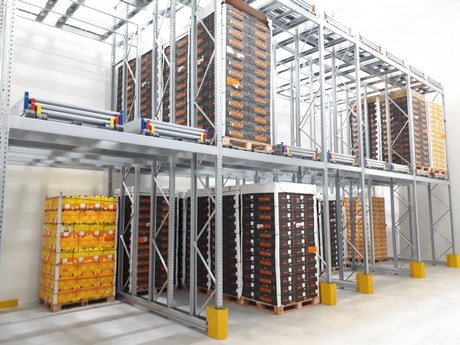It became essential for the Dutch company, Combilo to expand. This was due to an increase in trade of existing and new product groups. This company found that drive-in racks were not suitable for their new cooling cells. This storage solution is very labor-intensive. Its load capacity is also often low. This is why Combilo opted for pushback racks with trolleys.

The stored products had to be easy to trace and quick to access. This is in accordance with set requirements. The traceability is managed by adding a barcode sticker to each incoming batch. Quick access is guaranteed by the use of a unique shelf system.
According to Dexion, who supplied the system, "By using the pushback racks with trolleys, the storage method (LIFO) is basically still the same as a drive-in rack. However, it is easier to store and retrieve goods on each level."
"Using gravity, the trolleys move toward the order picker when the frontmost pallet is removed. The forklift operator, therefore, only has to load and offload goods onto the rack from the aisle. The forklift does not, as with a drive-in installation, have to drive into the racks. The pushback sections are also not too deep. The racks are four or five trolleys deep."
"This means four or five blocks of euro pallets can be stored per section. The advantage of this is that the various suppliers' goods can be stored in separate sections. In this way, Combilo can store supplier A's products on the top level. The bottom two can be used for supplier B's goods."
In order to be future-proof, Dexion advised the company to increase their pallet load capacity from 1,200 kg to 1,400 kg. "This means citrus can be stored on each level. You do not have to consider where it may, or may not, be stored in the warehouse."
"The trolleys were also made longer. They now measure 1.050 mm. That is 'only' 50 mm more. However, this ensures that pallets with overflow can be stored with a reduced risk of damage. The trolleys' unique shape ensures that the pallets can be placed horizontally. This prevents damage and the risk of the load toppling forward."
"The colored 'operating fins' ensure that the operator can see how many pallets there are per storage lane. The operator can also use these finds to place the next pallet on the rack. This, without the pallets or loads, touching each other."
"During the design phase, Dexion also took the forklifts' mast height into account. The bottom pallets simply stand on the floor. The forklift may only have one certain mast height to reach the pallets effortlessly. Thanks to clever engineering, Dexion came up with the best height division of the pushback installation", the installer continues.
"These racks are equipped with pillar protectors. They have a guard rail that runs the length of the section. At the rear, there is one at floor level which is fitted with corner lines. In this way, collision damage is kept to a minimum."
"The frames, lifters, rails, and trolleys are manufactured entirely from galvanized metal. As a result, Combilo now has a cooling cell with pushback racks suited to the storage of about 2,000 block pallets."
“Warehouse racks are a strange purchase for us. We have never had to buy them. All the current drive-in racks were already installed when we bought the building", says Richard van Bergenhenegouwen, Director of Operations & Logistics at Combilo.
"However, due to the large drive-in depth needed, these are not ideal for quick storage and traceability of goods. Dexion gave us a good feeling. They had detailed sketches with precise measurements. They advised us to adjust something here and there in order for us to be more future-proof."
"This ensures that we are flexible in what products we want to store and where we want to store them. The extra expense of a system that can bear heavier loads was, considering the entire project, relatively acceptable. It was, therefore, not a very difficult choice to make", he concludes.
For more information
Constructor Dexion Holland BV
23H Nijverheidsweg
3641 RP Mijdrecht
Tel: +31 (0) 297 239 400
info@dexion.nl
www.dexion.nl
